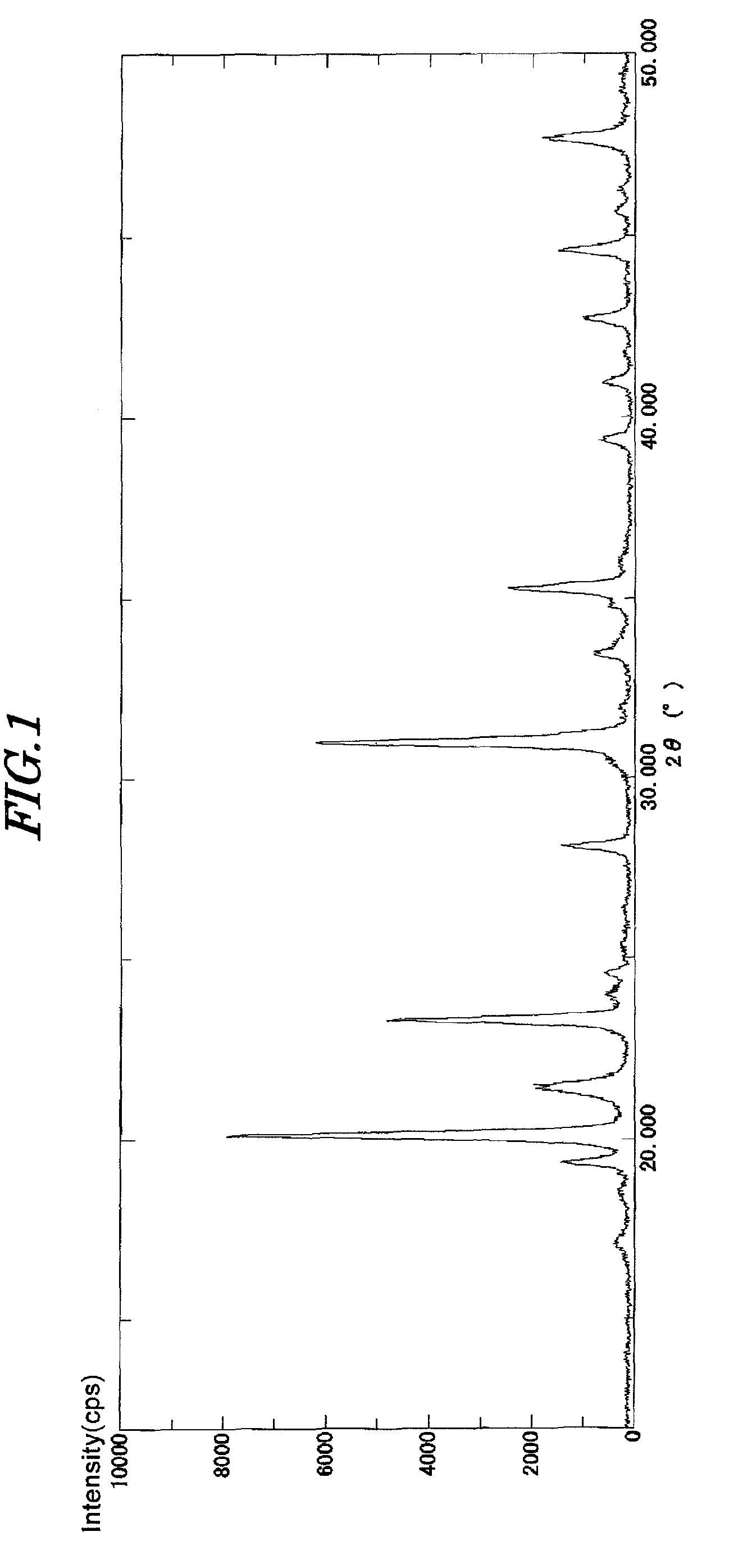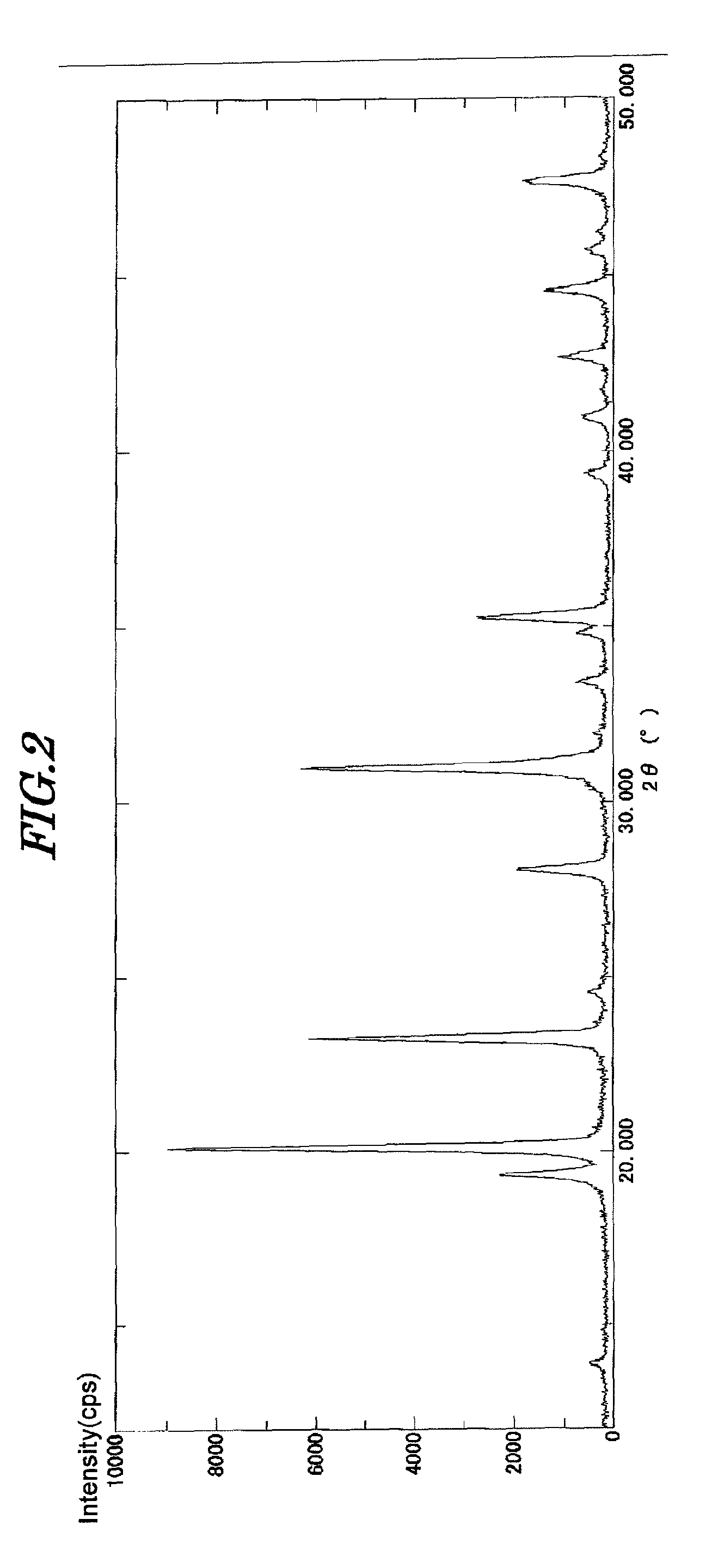Silver-based inorganic antimicrobial agent, method for preparing the same and antimicrobial product
a technology of inorganic antimicrobial agents and silver-based silver, which is applied in the direction of disinfectants, antibacterial agents, biocide, etc., can solve the problems of quality and production efficiency problems, easy to uniformly mix raw materials, and difficult to obtain zirconium phosphate with a homogeneous composition, etc., to achieve superior antimicrobial effects and long-lasting waterproofness
- Summary
- Abstract
- Description
- Claims
- Application Information
AI Technical Summary
Benefits of technology
Problems solved by technology
Method used
Image
Examples
example 1
[0118]0.1 moles of oxalic acid dihydrate, 0.2 moles of zirconium oxychloride octahydrate containing 0.17% of hafnium, and 0.05 moles of ammonium chloride were dissolved in 300 mL of deionized water, and 0.3 moles of phosphoric acid were added thereto while stirring. The pH of this solution was adjusted to 2.6 using a 20% aqueous sodium hydroxide solution, and the solution was then stirred at 98° C. for 14 hours. Subsequently, the precipitate thus obtained was washed well and dried at 120° C. to synthesize a zirconium phosphate compound.
[0119]Respective component amounts of this zirconium phosphate compound were measured and a composition formula thereof was obtained as follows:
Na0.6(NH4)0.4Zr1.98Hf0.02(PO4)3.0.09H2O
[0120]450 ml of an aqueous solution of deionized water obtained by dissolving 0.05 moles of silver nitrate was added to 0.09 moles of zirconium phosphate thus obtained, followed by stirring at 60° C. for 2 hours, to support silver. After the silver-supporting process, the...
example 2
[0124]A silver-supporting process using the zirconium phosphate having the following composition formula obtained in Example 1 was changed as follows.
Na0.6(NH4)0.4Zr1.98Hf0.02(PO4)3.0.09H2O
[0125]450 ml of an aqueous solution of deionized water obtained by dissolving 0.05 moles of silver nitrate was added to 0.09 moles of zirconium phosphate thus obtained, followed by stirring at 60° C. for 2 hours, to support silver. After the silver-supporting process, the resulting slurry was filtered and washed with water, the filtrate was washed until the electrical conductivity of the filtrate reached 380 μS, and the resulting solid was dried at 120° C. and bulk specific gravity thereof was adjusted to 1.00.
[0126]Respective components of the dried solid composed of the silver-supported zirconium phosphate were measured and the resulting composition formula was given as follows:
Ag0.55Na0.05H0.55Zr1.98Hf0.02(PO4)3.0.14H2O
[0127]Furthermore, the dried product was treated using a gas furnace at 900°...
example 3
[0129]A silver-supporting process using the zirconium phosphate having the following composition formula obtained in Example 1 was changed as follows.
[0130]Na0.6(NH4)0.4Zr1.98Hf0.02(PO4)3.0.09H2O
[0131]450 ml of an aqueous solution of deionized water obtained by dissolving 0.05 moles of silver nitrate was added to 0.09 moles of zirconium phosphate thus obtained, followed by stirring at 60° C. for 2 hours, to support silver. After the silver-supporting process, the resulting slurry was filtered and washed with water, the filtrate was washed until the electrical conductivity of the filtrate reached 240 μS, and the resulting solid was dried at 120° C. and bulk specific gravity thereof was adjusted to 1.25.
[0132]Respective components of the dried solid composed of the silver-supported zirconium phosphate were measured and the resulting composition formula was given as follows:
Ag0.55Na0.35H0.25Zr1.98Hf0.02(PO4)3.0.11H2O
[0133]Then, the dried product was treated using a gas furnace at 800° ...
PUM
 Login to View More
Login to View More Abstract
Description
Claims
Application Information
 Login to View More
Login to View More - R&D
- Intellectual Property
- Life Sciences
- Materials
- Tech Scout
- Unparalleled Data Quality
- Higher Quality Content
- 60% Fewer Hallucinations
Browse by: Latest US Patents, China's latest patents, Technical Efficacy Thesaurus, Application Domain, Technology Topic, Popular Technical Reports.
© 2025 PatSnap. All rights reserved.Legal|Privacy policy|Modern Slavery Act Transparency Statement|Sitemap|About US| Contact US: help@patsnap.com


